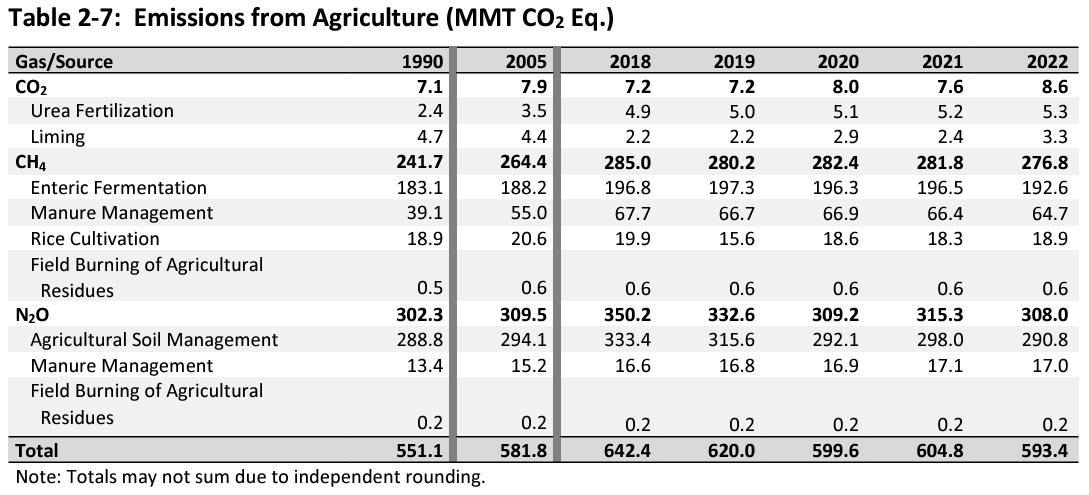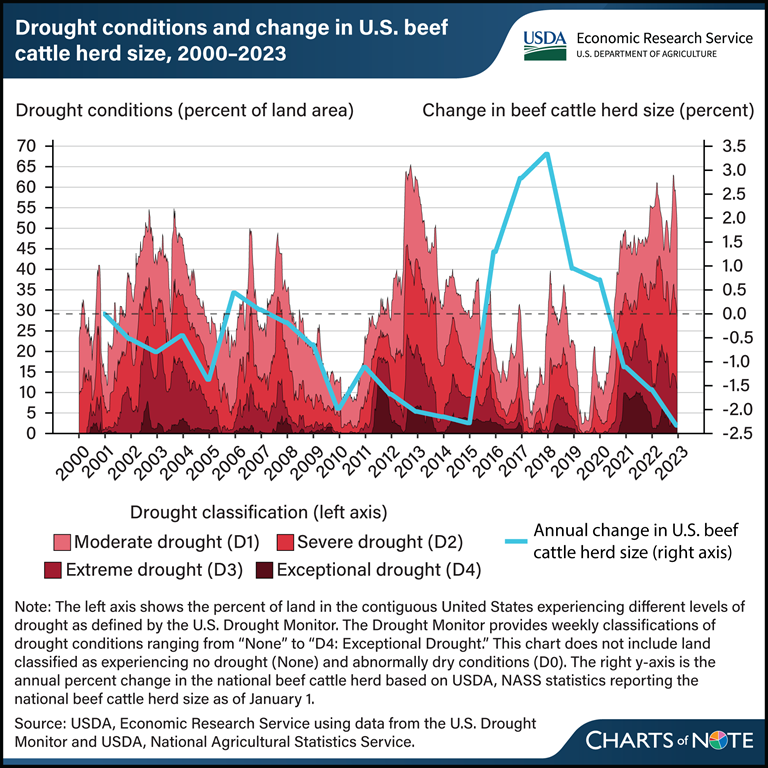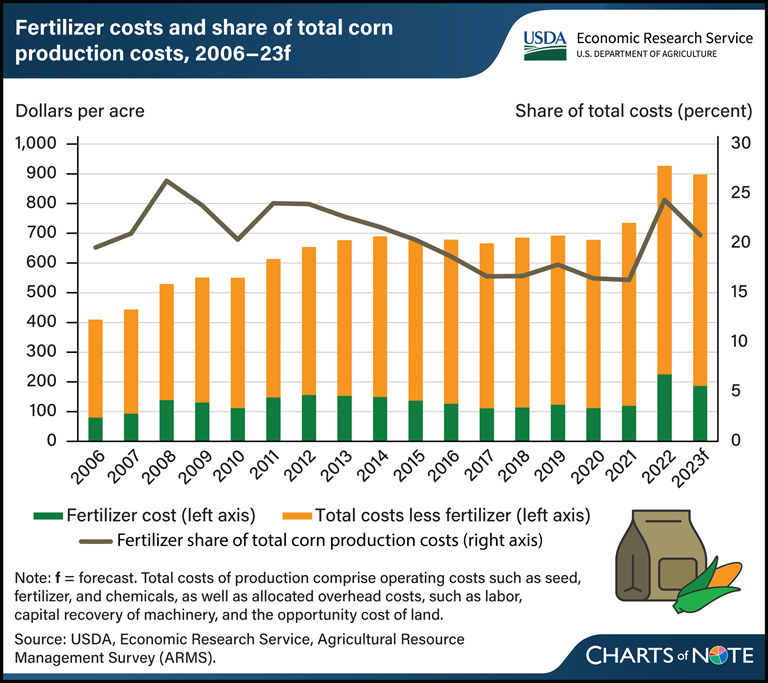The Environmental Protection Agency (EPA) reported today that greenhouse gas (GHG) emissions from agriculture fell in 2022, even as overall United States emissions rose. Two major disruptions to the agricultural economy were responsible for the emissions drop: a decline in the cattle herd (now the smallest since 1961) due largely to a multi-year drought and a spike in fertilizer prices. Methane from cows and nitrous oxide from fertilizer are the biggest sources of U.S. agricultural GHGs.
The decline in 2022 agriculture emissions was not due to any new climate or farm policy. Instead, it reflects the year-to-year volatility of the U.S. farm economy. Climate-related shocks (such as drought, heat, flooding, plant and animal disease) to our farming system are expected to increase, according to the latest National Climate Assessment. Yet, judging from the current Farm Bill debate, policymakers remain reluctant to make reforms that reflect the urgency of the climate crisis and chart an agricultural transition that reduces emissions and promotes economic and climate resilience for family farms and rural economies.
The EPA’s greenhouse gas inventory found net U.S. emissions increased 1.3% from 2021 to 2022. The EPA attributed most of the 2022 increase to increased fossil fuel emissions tied to the rebounding economy and increased travel following the COVID-19 pandemic. Unfortunately, separate measurement data from the National Oceanic and Atmospheric Administration (NOAA) released this month found that U.S. emissions continued to rise in 2023. The Biden administration’s climate target seeks a 50% reduction (from 2005 levels) in GHGs by 2030 and to reach net zero by 2050. The new numbers reveal that the U.S. is off track. So far, the U.S. has reduced emissions by only 16.7% from 2005 levels.
While agriculture emissions have increased most years since 1990, the EPA found that agriculture emissions declined 1.9% in 2022. Agriculture is responsible for 9.4% of U.S. emissions (on-farm energy and transportation are included in other sectors of the inventory). In 2022, agriculture’s largest source of emissions was nitrous oxide (265 times more potent than CO2 over 100 years), released through soil management activities, such as synthetic fertilizer application. Enteric fermentation from ruminant animals, primarily beef and dairy cows, was the largest source of overall methane emissions (27%). Methane is 28 times more potent than carbon dioxide over 100 years, under the EPA’s methodology. (Because methane stays in the atmosphere for around a decade, others, including IATP, use a 20-year time-frame where methane is 80 times more potent than carbon dioxide.) Manure management on large-scale concentrated animal feeding operations (CAFOs) is the fourth largest source of methane and the second largest source of agricultural nitrous oxide, according to the EPA. It is the liquifying and storage of manure on large CAFOs that causes increased emissions, whereas solid manure management and pasture-based systems on smaller-scale farms pose less of a problem. The EPA reports, “When livestock manure is stored or treated in systems that promote anaerobic conditions (e.g., as a liquid/slurry in lagoons, ponds, tanks, or pits), the decomposition of the volatile solids component in the manure tends to produce CH4 (methane). When manure is handled as a solid (e.g., in stacks or drylots) or deposited on pasture, range, or paddock lands, it tends to decompose aerobically and produce CO2 and little or no CH4.”

Source: EPA, Trends in Greenhouse Gas Emissions and Removals.
Cattle herd and emissions
EPA reported the drop in methane from enteric fermentation by 2% from 2021 to 2022 was “largely driven by a decrease in beef cattle populations.” The EPA attributes a similar drop in emissions from manure management to a decline in animal populations. Though recent research using aerial and satellite measurements suggest that the EPA may underestimate significantly agriculture and oil and gas methane emissions.
While the U.S. cattle herd typically has cycles of growth and contraction, the recent drop linked to a multi-year drought has been dramatic. The herd is now at its lowest level in 61 years, the U.S. Department of Agriculture reports. Industry analysts believe the cattle herd could decline further in 2024 and take several years before it starts to rise again.

Source: USDA, Drought conditions influence annual fluctuations in U.S. beef cattle herd size.
A multi-year drought, beginning in 2020, has hit most Western and Midwest states, including many leading cattle producing states, such as Texas, Missouri, Oklahoma and South Dakota. Drought has led to less pastureland. An Investigate Midwest analysis found Missouri and Nebraska experienced the largest decline in healthy pastureland since 2020. When drought conditions hit, ranchers are more likely to cull cattle due to increased feed and water-related costs.
Cattle have also been affected by a series of extreme weather events over the last several years. Wildfires in Texas this February killed at least 7,000 cows, and heat stress was linked to the deaths of 10,000 cows in Kansas in 2022. Extreme heat and smoke from wildfires have adversely affected dairy cattle and milk production.
Rising fertilizer costs lead to less corn and drop in emissions
Agriculture emissions from the potent GHG nitrous oxide (N20) dropped 2.9% from 2021 to 2022. N20 emissions from fertilizer use, surface leaching and runoff into waterways all dropped in 2022, the EPA reported.
The use of nitrogen fertilizer is tied to corn production. The EPA reported that “Direct N2O emissions from croplands occur throughout all of the cropland regions but tend to be high in the Midwestern Corn Belt Region (particularly, Illinois, Iowa, Kansas, Minnesota, Nebraska), where a large portion of the land is used for growing highly fertilized corn and nitrogen-fixing soybean crops…Indirect N2O emissions from surface runoff and leaching of applied/mineralized nitrogen in croplands is highest in the Midwestern Corn Belt.”
When nitrogen fertilizer prices spiked in 2021 and 2022, many farmers switched to other crops that require less fertilizer, most often soybeans. While the price spike was partially attributed supply chain disruptions linked to the war in Ukraine, an IATP and GRAIN analysis concluded that big fertilizer companies also engaged in excess profiteering during this period.

Source: USDA, Fertilizer share of expected corn production expenses drops back after 2021–22 spike.
As fertilizer prices dropped in 2023, corn production rebounded, indicating that nitrous oxide emissions may also rise again in 2023.
Carbon sink declines
The Biden administration’s 2030 climate target cites the importance of the nation’s managed land, including farmland and forestry, to serve as an expanding carbon sink. In addition to tracking emissions, the EPA estimates land-based carbon sequestration. Carbon sequestered in managed land in the U.S. declined by 6.3% from 2022 to 2021, the EPA reported. Most of that decline is linked to land lost in forests and farmland, including to development, forest fires and flooded land. The amount of carbon sequestered on land has declined nearly 11% in the U.S. since 1990, the EPA reported.
Lessons for policymakers
The decline in U.S. agriculture emissions in 2022 is not surprising, given what is known about the contraction of the cattle herd, the spike in fertilizer prices and the reduction in corn acres. Unfortunately, the 2022 reductions were not part of a planned strategy to support farmers in a transition toward less emitting, more resilient agricultural systems. Instead, the reductions were the result of sudden shocks that caused enormous harm to farmers and their animals. Volatile prices make it nearly impossible for farmers to plan ahead or transition to more diverse cropping systems that require less fertilizer use.
Neither the current Farm Bill, nor the Farm Bill under consideration by Congress, prioritizes a transition out of the high-emitting factory farm system for animal production, which depends on fertilized corn for feed. While Congress has allocated additional resources to federal farm conservation programs through the Inflation Reduction Act, too many farmers remain closed out of the programs and too much conservation money goes to factory farms. A host of Farm Bill programs, from commodity and crop insurance programs to loans and credit, support the overproduction of below-cost commodity crops. Instead, the Farm Bill could support programs that would stabilize production and prices to reduce volatility and incentivize investments in more diverse, climate resilient farming systems. Policymakers continue to defer to the wants of powerful global grain and meat companies, while climate-related events, such as drought, wildfires and floods, warn us that change is coming, ready or not.
